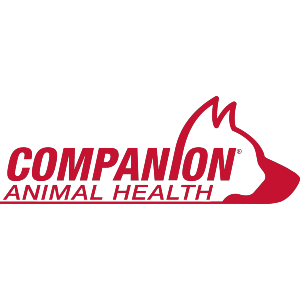-
Beam Area
The area of the beam on a surface. The beam area will depend on the treatment head used and the distance the treatment head is held from the surface. Instead of beam area, laser physicists use laser “spot size.” The spot size is either the beam radius or beam diameter, depending on the definition used. This is further complicated because the intensity of Gaussian laser beams decreases from a central maximum gradually to 0 at the edges. Since there is no clearly defined edge at which to measure the beam’s radius or diameter, “spot size” will depend on the spot size definition used (e.g., full width at half maximum or distance from maximum irradiance to irradiance of 1/e2). Nevertheless, by using a scanning application of PBM treatment, any inhomogeneities in the beam irradiance are averaged over the whole treatment area.
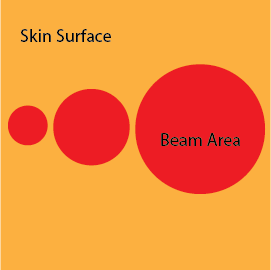
-
Terminology Commonly Used: Spot Size
Symbol: As
Units: cm2
-
Treatment Area
Area of the skin surface that is treated. For Companion lasers, this area is larger than the beam area.
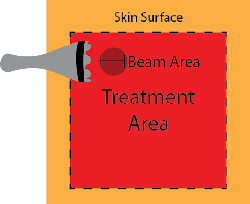
-
Symbol: At
Units: cm2
-
Treatment Time
Total time of a treatment to the entire treatment area.
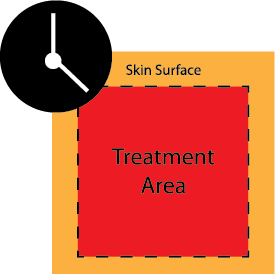
-
Symbol: t
Units: s
-
Exposure Time
Definition: Time that surface is exposed to the beam.
For scanning treatment with a LiteCure laser, the total treatment area is covered. Assuming a uniform treatment to the skin, then the total exposure time of the skin to the beam during the treatment is related to the total treatment time by the ratio of the beam area to the treatment area. Hence, ts = t x (As/At).
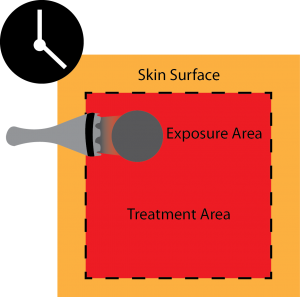
-
Symbol: ts
Units: s
-
Power (Radiant Flux)
Radiant energy emitted per unit time.

-
Terminology Commonly Used: Power
Units: watt (W)
-
Pulse Frequency
When referring to therapy lasers, most practitioners use the term frequency to mean the pulse frequency of the laser. Therapy lasers can operate in continuous or pulsed mode. The pulse frequency is the number of times the laser is turned on and off during a second.
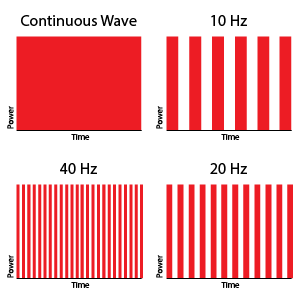
-
Terminology Commonly Used: Frequency
Units: hertz (Hz) or s-1
-
Duty Cycle
This term is used for pulsed lasers. It is the percentage of one period in which the laser is emitting. For Companion lasers operating in pulsed mode, the duty cycle is 50%.
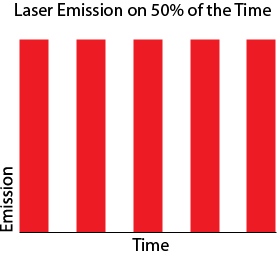
-
Symbol: D
-
Energy Delivered
The total energy delivered during a treatment is determined by multiplying the average power during the treatment by the total treatment time.
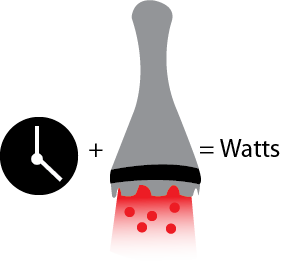
-
Unit: joule (J)
-
Irradiance
The output power of the laser divided by the beam area; the power intensity at the surface of the skin.

-
Terminology Commonly Used: Power density Symbol: E Units: W/cm2
-
Dose
Standard Dosimetry Definition
Dose = Irradiance x exposure time = E x ts
Units: joules/cm2 = J/cm2
For calculation of dose delivered during scanning
First, let us assume that the treatment beam is uniform. In this case, the irradiance would then be the power divided by the beam area, E=F/As.
With the exposure time ts = t x (As/At).
Putting these together: Dose = Irradiance x exposure time
= (F/As) t x (As/At)
= F t /AtThis is the total energy delivered divided by the total treatment area.
For Companion Lasers, the dose will be the total energy delivered to an area divided by the total area (skin surface area) to which it was delivered. This assumes that scanning covers the treatment area evenly to distribute an even dose to the tissue. By scanning the entire area evenly any inhomogeneities in the beam are averaged over the whole treatment area.
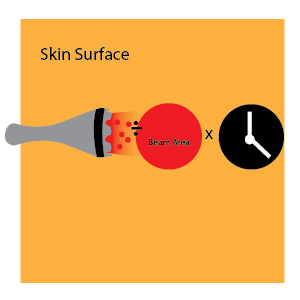
-
Units: J/cm2

-
Wavelength
The distance between two consecutive peaks of an electromagnetic wave.

-
Symbol: λ
Units: nm
Other Terms & Definitions
Term: adenosine triphosphate
Abbreviation or Other Terminology Used: ATP
Definition: Molecule in the cell that transports chemical energy for metabolism.
Term: chromophore
Definition: The part of the molecule that captures light energy.
Term: continuous wave
Abbreviation or Other Terminology Used: CW
Definition: A laser that runs at constant output power.
Term: cytochrome c
Definition: A component of the electron transport chain in mitochondria.
Term: electromagnetic radiation
Definition: The radiant energy released by certain electromagnetic processes. Electromagnetic radiation includes radio waves, microwaves, infrared radiation, visible light, ultraviolet radiation, X-rays, and gamma rays. Also see electromagnetic spectrum.
Term: electromagnetic spectrum
Definition: The range of wavelengths and frequencies of electromagnetic radiation (see figure below).
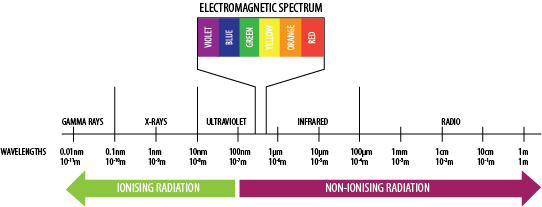
Term: endogenous
Definition: Growing or originating from within an organism.
Term: mitochondrion (pl. mitochondria)
Definition: An organelle found in large numbers in most cells, in which the biochemical processes of respiration and energy production occur.
Term: near-infrared (NIR) window
Abbreviation or Other Terminology Used: therapeutic or optical window
Definition: The range of wavelengths from 650 nm to 1350 nm where light has its maximum depth of penetration in biological tissue (see figure below). Visit the Wavelength Selection page for details about water absorption and to see the various absorption coefficients as a function of wavelength on a linear scale.
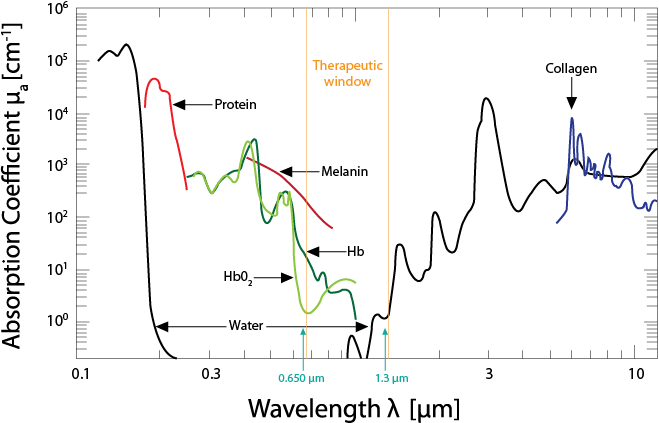
Term: nitric oxide
Abbreviation or Other Terminology Used: NO
Definition: Important cellular signaling molecule involved in many physiological and pathological processes.
Term: protocol
Definition: Predefined treatment sequence programmed into the laser software.
Term: reactive oxygen species
Abbreviation or Other Terminology Used: ROS
Definition: Chemically reactive molecules containing oxygen.
Term: vasodilation
Definition: The widening of blood vessels, thus resulting in increased blood flow.
References
-
Anders JJ, Lanzafame RJ, Arany PR. Low-level light/laser therapy versus photobiomodulation therapy. Photomedicine and Laser Surgery. 2015; 33(4): 183-184.
-
Frydrych. The Evolution of Photobiomodulation link
-
Karu TI. Low power laser therapy. In: Vo-Dinh T, editor. Biomedical Photonics Handbook. Boca Raton (FL) CRC Press; 2003: 48-1-48-25.
-
Hamblin MR, Demidova TN. Mechanisms of low level light therapy. Proc. of SPIE. 2006; 6140: 612001-1-12.
-
Chung H, Dai T, Sharma SK, Huang Y-Y, Carroll JD, Hamblin MR. The nuts and bolts of low-level laser (light) therapy. Ann Biomed Eng. 2012; 40(2): 516-533.
-
Wu S, Xing D. Intracellular signaling cascades following light irradiation. Laser Photonics Rev. 2014; 8(1): 115–130.
-
FDA website http://www.fda.gov/RadiationEmittingProducts/Radiation EmittingProductsandProcedures/HomeBusinessandEntertainment/LaserProductsandIns truments/ucm451697.htm
-
FDA website www.accessdata.fda.gov (Accessed March 16, 2015.)
-
Conforti M, Fachinetti GP. High power laser therapy treatment compared to simple segmental physical rehabilitation in whiplash injuries (1° and 2° grade of the Quebec Task Force classification) involving muscles and ligaments. Muscles, Ligaments and Tendons Journal. 2013; 3(2): 106-111.
-
Vallone F, Benedicenti S, Sorrenti E, Schiavetti I, Angiero A. Effect of diode laser in the treatment of patients with nonspecific chronic low back pain: a randomized controlled trial. Photomedicine and Laser Surgery. 2014; 32(9): 490-494.
-
Roberts DB, Kruse RJ, Stoll SF. The effectiveness of therapeutic class IV (10W) laser treatment for epicondylitis. Lasers in Surgery and Medicine. 2013; 45(5): 311-317. doi: 10.1002/lsm.22140
-
Panton L, Simonavice E, Williams K, Majock C, Kim J-S, Kingsley JD, McMillan V, Mathis R. Effects of class IV laser therapy on fibromyalgia impact and function in women with fibromyalgia. The Journal of Alternative and Complementary Medicine. 2013. 19(5): 445-452. doi: 10.1089/acm.2011.0398
-
Morimoto Y, Saito A, Tokuhashi Y. Low level laser therapy for sports injuries. Laser Therapy. 2013; 22(1): 17-20.
-
Karlekar A, Bharati S, Saxena R, Mehta K. Assessment of feasibility and efficacy or class IV laser therapy for postoperative pain relief in off-pump coronary artery bypass surgery patients: A pilot study. Annals of Cardiac Anaesthesia. 2015; 18(3): 317-322. doi:10.4103/0971-9784.159800.
-
Tumilty S, Baxter D. Photobiomodulation and eccentric exercise for Achilles tendinopathy: a randomized controlled trial. Lasers in Medical Science. 2016; 31(1):127-135. doi: 10.1007/s10103-015-1840-4.
-
Hashmi JT, Huang Y-Y, Sharma SK, Kurup DB, De Taboada L, Carroll JD, Hamblin MR. Effect of pulsing in low-level light therapy. Lasers Surg Med. 2010; 42(6): 450–466. doi: 10.1002/lsm.20950.
-
Frostad M, Poulis G, Copeland G. Major league relief: Laser therapy provides non-invasive treatment for elite athletes and weekend warriors. ADVANCE, June 2009.
-
Smith S. A Modality with momentum: Laser therapy brings power to the Major League Baseball lineup. ADVANCE, June 2014.

